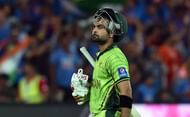Growing up watching cricket in the 1990s, you just could not stop raving about the skills of the Pakistan cricket team no matter how much you wanted to hate them. They had all those skills that made cricket attractive - fast bowlers, mysterious spinners, flamboyant batsmen. On the other hand were India, the exact antithesis. Batsmen who were more worried about getting out than scoring runs and ‘spinners’ who did not spin the ball and ‘fast bowlers’ who did not bowl fast.
India and Pakistan’s disinterest in the field
One thing common between both the teams was the pathetic ‘out cricket’ as Greg Chappell used to call it. Neither were interested in saving runs on the field nor running fast between the wickets. For Pakistan, at least, it did not matter. They were way too skillful for that to have a negative impact.
One will still remember the confidence (bordering on arrogance) with which Pakistan’s batsman use to meander along in the middle overs because they were so confident that they could catch up with the required run rate in the latter overs with the hitting ability that they had.
India, at the same time, needed the help of good ‘out cricket’ to win more games. But barring Robin Singh and Ajay Jadeja, no one really seemed to give attention to that part of the game.
A changed India in the new millennium
However, with the turn of the millennium, things changed. Indian cricket diversified, its talent came in from different parts of the country and things started to change. Indian cricket moved out of the clique dominated by Bombay, Karnataka and other entrenched cricketing centres to accommodate exciting talent from other parts of the country. We had as captain Sourav Ganguly from the East, the dashing and daring Yuvraj Singh, Harbhajan Singh from Punjab and Mohammad Kaif and Virender Sehwag from the North.
Almost as if mirroring the changes in the economy of the country, these young guns did not give a damn to the traditional Indian way of playing cricket and started to change the contours of Indian cricket. Sehwag did not care if he would get out in the 90s while attempting a sixer, Yuvraj did not care for reputation when he hammered Glenn McGrath and Brett Lee on his debut, Ganguly couldn't care less for the etiquette of the MCC or the ugliness of his hirsute chest when he took his shirt off on the balcony at Lord’s.
Kaif also perhaps became the first Indian cricketer of the South Africa/New Zealand mould. Not flamboyant, not glamorous but more than productive in the team’s efforts with his brilliant fielding and running between the wickets. The arrival of MS Dhoni was the real icing on the cake. He was everything that Indian cricket was not when it was not at its peak until the 90s. Small town boy, unorthodox, never let his guard down, always hard working. He was as much South African in his cricket as any Indian cricketer has ever got.
Pakistan have gone backwards
For Pakistan, unfortunately, things moved in the reverse direction. A great generation of fast bowlers quit and the new generation just does not seem to be ready for the changed world of cricket. They still believe in their old strengths and just refuse to believe that the game has moved on.
Ahmed Shehzad is a wonderful case in point. For all his wonderful shot-making ability, he must be one of the worst batsmen at rotating the strike. The other day against India, he played 74 balls to score at a strike rate of only 64 which is really unacceptable in this day and age, especially when you are chasing above 300. Also, this was against an Indian attack that was by no means a great one.
In fact, it is tough to think of one Pakistani batting pair that ran well between the wickets. Misbah-ul-Haq’s final stats might look good, but even he doesn’t have the tendency to rotate the strike and keep the scoreboard moving.
I know several Pakistan cricket commentators found an easy scapegoat in Younis Khan but what must be really worrying is the outdated cricket that some of its youngsters play. If anything Younis is a better fielder and runner between the wickets than most of them. Not to say that India are great at modern-day cricket, but they are definitely better and have acknowledged the need for doing it more than Pakistan have.
Change is the only constant
India and Pakistan (more so) should realise that things have changed. Just skill will not get you anywhere in today’s world of sport. For long, we have heard the incredibly stupid excuse that our hockey teams would do better if we were still playing on grass. That is a load of rubbish because it is actually easier to play on astroturf. Easier to pass, easier to run. It is just that other teams have become better. They are more athletic, more clever, more tactical.
India has been more akin to a student willing to learn in this matter. The win the other day was a manifestation of that as much as anything else. One team that is still stuck in ancient ways and the other that has made an effort to come out of it. As long as Pakistan do not realise that, they will keep wondering ‘Kab phorenge’?
Follow IPL Auction 2025 Live Updates, News & Biddings at Sportskeeda. Get the fastest updates on Mega-Auction and cricket news

